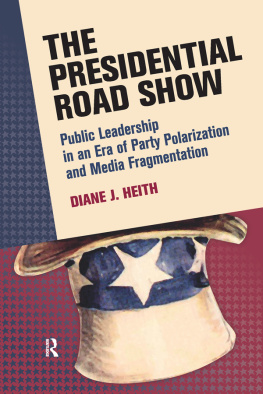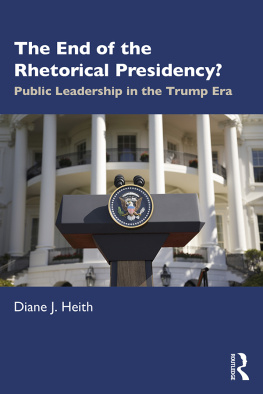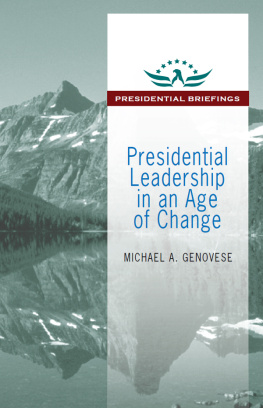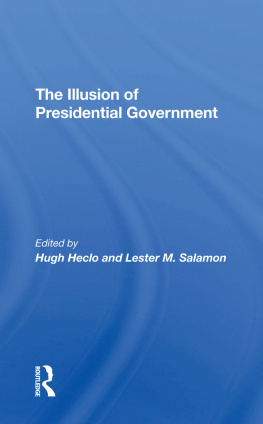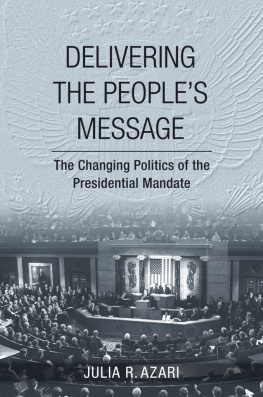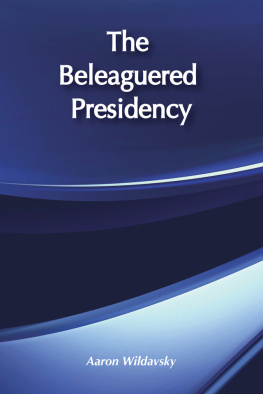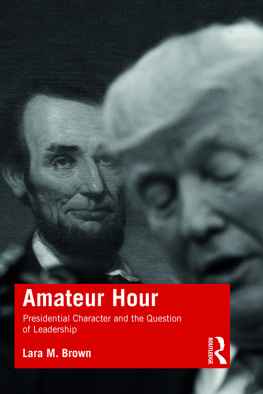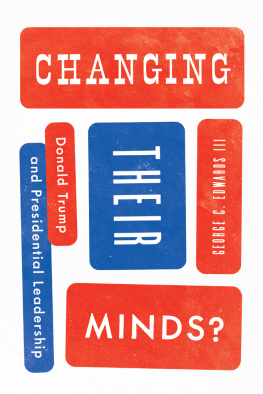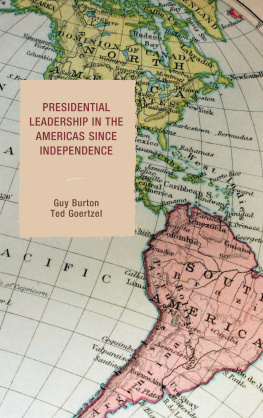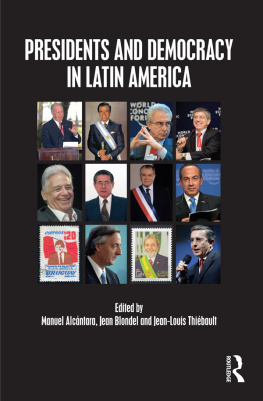THE PRESIDENTIAL ROAD SHOW
THE PRESIDENTIAL ROAD SHOW
PUBLIC LEADERSHIP IN AN ERA OF PARTY POLARIZATION AND MEDIA FRAGMENTATION
DIANE J. HEITH
First published 2013 by Paradigm Publishers
Published 2016 by Routledge
2 Park Square, Milton Park, Abingdon, Oxon OX14 4RN
711 Third Avenue, New York, NY 10017, USA
Routledge is an imprint of the Taylor & Francis Group, an informa business
Copyright 2013 Taylor & Francis.
All rights reserved. No part of this book may be reprinted or reproduced or utilised in any form or by any electronic, mechanical, or other means, now known or hereafter invented, including photocopying and recording, or in any information storage or retrieval system, without permission in writing from the publishers.
Notice:
Product or corporate names may be trademarks or registered trademarks, and are used only for identification and explanation without intent to infringe.
Library of Congress Cataloging-in-Publication Data
Heith, Diane J., author.
The presidential roadshow: public leadership in an era of party polarization and media fragmentation / Diane J. Heith.
pages cm. (Media and power series)
Includes bibliographical references and index.
ISBN 978-1-59451-850-8 (hardcover: alk. paper)
1. PresidentsUnited StatesHistory21st century. 2. PresidentsUnited
StatesHistory20th century. 3. Political leadershipUnited StatesHistory
21st century. 4. Political leadershipUnited StatesHistory20th century.
5. United StatesPolitics and government1989 I. Title.
JK511.H45 2013
352.2360973dc23
2012039108
ISBN 13 : 978-1-59451-850-8 (hbk)
ISBN 13 : 978-1-59451-851-5 (pbk)
For Owen
CONTENTS
In the past twenty-five years, the political environment in which presidents func-tion has changed significantly. It is more partisan, more fragmented, and more uncertain. Presidents face a party system characterized by purity, where moderate presidential and congressional candidates cannot easily survive primaries when challenged by their party ideologues. In addition, presidents face a public sphere replete with voices. No longer do the big three television networks and a handful of newspapers and radio stations dominate the dissemination of the presidents message. Cable channels parse presidential politics 24/7. Television pundits flourish by offering opinions presented as facts. Online, the Internet magnifies citizen voices, and the pundocracy has expanded to include bloggers with and without traditional credentials.
These changes in the political environment have changed the context under which the president governs. More significantly, these changes put constraints on presidential leadership. In The Presidential Road Show, I contend that the electoral and media environments are what provide the president a perch from which to govern nationally. Specifically, the election, which gives the president his office, also provides the president with his constituency, be it large or small. The election determines how national, and thus how supportive, the presidential audience is. Presidents who sail into office with large Electoral College victories can claim to represent the nation at large. Conversely, presidents with narrow victories have trouble claiming a national audience let alone national support.
The media environment in which presidents try to reach their audience also influences the type of leadership presidents can exercise. As scholars and presi-dents have noted, since 1992, a different tone has pervaded media coverage of the presidency, replete with negativity, cynicism, and the perceived bias of the national press corps. Moreover, the myriad of media outlets makes it difficult for any president to count on reaching the majority of the nation in a given speech or press conference.
In The Presidential Road Show I argue that the way in which the electoral and media environments intersect constrains opportunities for public leadership. Presidents with a national constituency and a national media environment can take the traditional route to reach their audience, delivering national addresses and occasionally traveling around the country in support of the presidential agenda. In contrast, a president with a narrow electoral victory and thus little national support cannot rely on national addresses alone, so he travels the country exercising rhetorical leadership targeted toward specific sectors of his constituency. A president who won a narrow victory in a contentious media environment also travels, seeking friendlier media coverage and the opportunity to influence members of Congress directly.
I use the presidential rhetoric of Bill Clinton, George W. Bush, and Barack Obama to determine how the mythology of national representation competed with the partisan warfare in which they governed (unless otherwise noted, all excerpts of presidential speech in this book come from the American Presidency Project, http://www.presidency.ucsb.edu). I find that presidents speak with one voice, to one nation, only in areas that are truly national: disasters, wars, crises, and foreign policy. However, across the presidents domestic agenda, the ideal of national representation collapses under the political realities of partisanship and communication requirements. Partisanship and the new media environment combine to shape a different leadership context, one that makes national leader-ship strategies, even at the local level, less appealing to the president and his staff.
For multiple reasons, this book took what felt like an eternity to complete. At every stage there were supportive people without whom this project might have collapsed under its own weight. At St. Johns University, I was granted a timely research leave, which moved the project from a solid idea to something more coherent, substantial, and supported by data. Dozens of graduate assistants and student workers toiled over the tedious data-gathering the book required. Special thanks go to Patricia Bittner for supervising the crew and to Kathleen McTigue, Michael Perez, Jamie Beran, Brian Meehan, and Ryan Covino for working as quickly as possible to input the seemingly endless stream of data. I would also like to thank David Paletz, Jennifer Knerr, and the anonymous reviewers for their assistance and encouragement.
Many friends and colleagues influenced the quality of data and argument presented here. Roderick Hart and his text analysis software, DICTION, offered me a means to measure what at times seemed immeasurable. I owe an enormous debt of gratitude to John Woolley and Gerhard Peters and their American Presidency Project for providing the text of all presidential speech in a searchable format. This book would not have been possible without their incredibly comprehensive website and their assistance with the data. I am also grateful to the scholars who provide me with support, scholarly assistance, and friendship: Kristin Le Veness, Lori Cox Han, Tim Groeling, and Victoria Farrar-Myers. Two friends and scholars, one a political scientist and one a linguist, went above and beyond the call of duty and provided thoughtful and skillful assistance at a critical moment. Endless thanks to you both, Mary Ann Borrelli and Angela Reyes!

